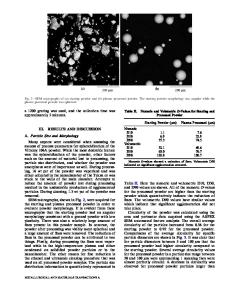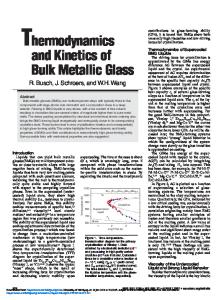Processing and Properties of Ni-Based Bulk Metallic Glass via Spark Plasma Sintering of Pulverized Amorphous Ribbons
- PDF / 1,087,920 Bytes
- 6 Pages / 432 x 648 pts Page_size
- 63 Downloads / 306 Views
Processing and Properties of Ni-Based Bulk Metallic Glass via Spark Plasma Sintering of Pulverized Amorphous Ribbons Alexander. S. Petersen1, Andrew. M. Cheung2, Henry. J. Neilson3, S. Joseph. Poon1, Gary. J. Shiflet2, and John. J. Lewandowski3 1
Department of Physics, University of Virginia, Charlottesville, VA 22904-4714, U.S.A.
2
Department of Materials Science and Engineering, University of Virginia, Charlottesville, Virginia 22904-4259, U.S.A.
3
Department of Materials Science and Engineering, Case Western Reserve University Cleveland, OH 44106-7204, U.S.A.
ABSTRACT
Ni-based bulk metallic glasses and composites with high absolute densities exceeding 11 g/cm3 were synthesized via spark plasma sintering of Ni45Co10Ta25Nb20 powders produced from pulverized, melt-spun amorphous ribbons. Optimizing the synthesis via selection of sintering temperature, uniaxial load pressure, and powder mechanical screening yielded samples with relative densities of nearly 100% and hardness values in excess of 12.5 GPa without cracking. Mechanical testing included Weibull modulus determination for hardness and compression testing at 10-3 s-1 and 103 s-1 strain rates. The capability of using spark plasma sintering to fabricate high hardness, high density, large scale metallic glasses is demonstrated. The mechanical properties of these compacted comminuted melt-spun glass ribbons are presented.
Introduction In order to reach the cm-scale regime for Ni-based bulk metallic glasses (BMGs) it is imperative to design optimal creation pathways. Multiple methods exist to create amorphous systems two of which are of interest here: rapid solidification from the liquid state in the form of melt spinning and compaction of powder from the metallurgic process of ball milling. A recent report [1] on cm-scale Ni-based BMG systems created through powder metallurgy has demonstrated fracture strengths of nearly 2.5 GPa with high relative densities. However, little work has been reported on Ni-based BMG systems with high strength and absolute density. This work focuses on the use of powder metallurgy techniques via a combination of melt spinning and ball milling to create Ni-based BMG systems with theoretical absolute densities above 11.0 g/cm3 and theoretical yield strengths in excess
Downloaded from https://www.cambridge.org/core. Teachers College Library - Columbia University, on 30 Nov 2017 at 02:22:21, subject to the Cambridge Core terms of use, available at https://www.cambridge.org/core/terms. https://doi.org/10.1557/adv.2017.605
of 4.0 GPa. Spark plasma sintering (SPS) was used to fabricate large cylindrical samples with diameters of 9.75 mm and a height of about 4 mm with nearly 100% relative density. Ni45Co10Ta25Nb20 was selected due to a high shear modulus of 85 GPa and a hardness value of 12.75 GPA when theoretically modeled using the rule of mixtures and a favorable glass formability based on phase diagrams. Optimization of particle size and compaction parameters during SPS was performed to limit crystallization and achieve the hi
Data Loading...











